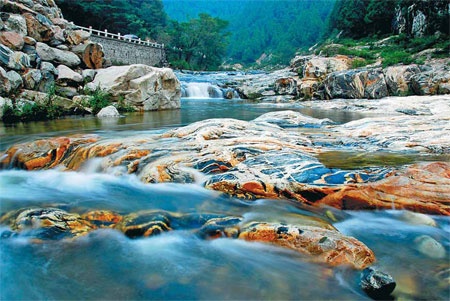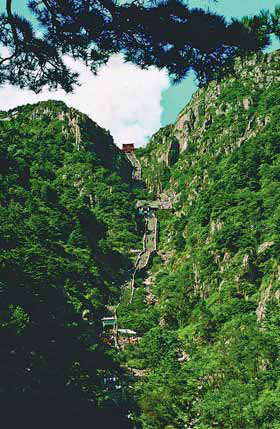Close to perfect
Updated: 2012-05-31 08:48
By Chitralekha Basu and Wang Qian (China Daily)
|
||||||||
 |
|
A crystal-clear stream is full of colorful stones formed about 2.8 billion years ago in Peach Blossom Valley, one of Mount Taishan's best-kept secrets. Provided to China Daily |
 |
|
Mount Taishan is now covered with lush forests, due to a successful forestation drive launched in 1999. Wang Dequan / for China Daily |
Related: Between a rock and a valley
Mount Taishan is a huge tourist attraction that requires significant efforts to maintain. Chitralekha Basu and Wang Qian find out more about what is being done to preserve the peak.
One of the five sacred Chinese Taoist peaks, Mount Taishan is a bit crowded at the top. Favored by monks and emperors since Qin Shihuang (259-210 BC), the mountain seems incredibly peopled - especially at the Jade Emperor's Summit, 1,545 meters above sea level.
Tourist traffic has multiplied over the years, from 1.7 million in 2004 to 3.4 million in 2011. As footfalls increase, the task of protecting this national treasure becomes more demanding.
Protecting Paleolithic rocks is no mean task. And neither is preserving the ecological balance and the spiritual ambience of a mountain that seems like a homage to more than 2,000 years of Chinese culture, which the historian Sima Qian (135-86 BC) saluted and Tang Dynasty poet Du Fu (AD 712-770) marveled at.
To find out if Mount Taishan was suffocating under heavy tourist traffic, we recently visited the site.
Indeed, the summit was rather noisy. The courtyard of the Goddess Bixia buzzed with pilgrims offering prayers and fastening newer locks to an ever-expanding brass pile of these, in the hope of bringing luck and blessings to their families.
A bevy of people eagerly awaited their turns to be photographed in front of the Sea-exploring Stone, which bore the inscription, "Mount Taishan - Mountain of Mountains".
A group broke into a synchronized drill and a song about the greatness of the mountain and Shandong province, where the peak is located.
All this was a bit at odds with the somber ambience one would have expected at a mountain that, traditionally, has served as a place of retreat for Buddhist, Taoist and Confucian pilgrims.
The Mount Taishan Scenic Spots Management Committee, which works with the local Tai'an government to protect the mountain and develop its potential as a tourist destination, is doing its bit.
As Wan Qinghai, its vice-director, told us, "We do take some measures trying to maintain quietness at the peak. The kiosks and tour guides on the mountain are not allowed to use high-decibel loudspeakers. Tourists are asked to lower their voices when they step inside the temples at the peak. Actually, most tourists are very devout and lower their voices on their own."
Xu Luchang, who has been running a store at Hotel Shen Qi on the peak for the last 10 years, says tourists have indeed gotten more responsible - "they don't litter the place with cigarette butts like they used to".
The management committee gets a thumbs-up from him. "They are working around the clock, in shifts, employing more people in the peak seasons."
One of the 1,600-odd regular people employed by the committee is garbage collector Sun Jiyu, who says his task is getting lighter with time. He picks up about 200 bottles a day in winter and more than double that in summer.
"Nowadays, tourists use the bins rather than littering," he says.
The more than 100 volunteers who serve as tour guides and environmental watchdogs during peak seasons have had a role in sensitizing tourists.
The Tai'an City Community Volunteers' Association sends a huge number of these people - students, workers, retirees and officials - to work alongside the staff.
As Hua Liangping, of the Association, says: "The idea is to lead by example, rather than trying to impose. We ask volunteers to pick up the garbage that a visitor might have, carelessly, dropped on the ground. But if they find a visitor smoking, they ask him to stop, as smoking is strictly prohibited on the mountain."
Checking the trees for pests is a major thrust of protecting the expansive green cover on Mount Taishan. It was quite bare until 1999, when a forestation drive was launched.
"Today, 82.4 percent of the total 12,000-hectare area is covered by forests while 94 percent is covered by foliage," Wan says.
Sun Xugen, professor of Plant Protection College of Shandong Agriculture University in Tai'an, says there is a potential threat from pests, such as the fall webworm moth and pinewood nematode, which, although not yet found on Taishan, have been located in the mountains of Zibo, only 200 km away.
A provincial pest control and research center has been established at Shandong Agriculture University to study treatments of the damage caused by pinewood nematodes.
Sometimes, the research center conducts experiments on Mount Taishan with the staff of the Pest Control and Quarantine Station at the mountain.
The man in charge of the arduous task of managing a team of 200 staff members who run checks - working both day and night shifts - on Taishan's trees is Shen Weixing, director of the Pest Control and Quarantine Station.
Shen, who often scrutinizes the trees at night, has introduced other measures to keep the pests at bay that seem to be working.
"There are checkpoints at every gateway to prevent people from carrying wooden furniture on the mountain, as these are potential carriers of pests. Only environmentally friendly pesticides are used, rather than chemical-based products. We often use one pest to kill another," Shen says.
Bird species like the magpie and the swallow have been brought in to help kill pests. And trees like oaks, pines and firs that better suit the mountainous terrain were planted in recent years to ensure a greater ecological balance, Shen says.
"The fact that Taishan is being reforested is very impressive," says John Wallace from the Asia Pacific Journalism Center in Melbourne, who has run several international conferences on climate concerns.
He also lauded the fact that only electronically powered vehicles were allowed to go up - and in limited numbers.
"People were taking rocks from the streams," he says. "That's been checked. In places, walls have been built to keep the rocks from falling off. It's great to see good policies are now in place."
Some of the amazingly colorful stones at Taishan - some formed 2.8 billion years ago - around Peach Blossom Valley gateway (see sidebar) were under layers of scum for years. These were cleaned up, at the cost of 50 million yuan ($7.9 million), according to Wan, revealing the mystifying patterns created on them were made through tectonic shifts.
"We have also built 23 dams to channel more water into the streams," Wan says.
Since the clean-up, visitors have stopped throwing trash into the stream.
"Earlier, the streams would get clogged up because rubbish thrown in them accumulated in the riverbed. Now, as you can see, the streams are absolutely crystal clear," Hua says.
"Generally speaking, the ecological balance around Mount Taishan is changing for the better," professor Sun, of Shandong Agriculture University, says.
It's not perfect yet, but there seems to be a concerted effort to get there.
Contact the writers at basu@chinadaily.com.cn and wangqian@chinadaily.com.cn.

 'Taken 2' grabs movie box office crown
'Taken 2' grabs movie box office crown
 Rihanna's 'Diamonds' tops UK pop chart
Rihanna's 'Diamonds' tops UK pop chart
 Fans get look at vintage Rolling Stones
Fans get look at vintage Rolling Stones
 Celebrities attend Power of Women event
Celebrities attend Power of Women event
 Ang Lee breaks 'every rule' to make unlikely new Life of Pi film
Ang Lee breaks 'every rule' to make unlikely new Life of Pi film
 Rihanna almost thrown out of nightclub
Rihanna almost thrown out of nightclub
 'Dark Knight' wins weekend box office
'Dark Knight' wins weekend box office
 'Total Recall' stars gather in Beverly Hills
'Total Recall' stars gather in Beverly Hills
Most Viewed
Editor's Picks

|

|

|

|

|

|
Today's Top News
Health new priority for quake zone
Xi meets US top military officer
Japan's boats driven out of Diaoyu
China mulls online shopping legislation
Bird flu death toll rises to 22
Putin appoints new ambassador to China
Japanese ships blocked from Diaoyu Islands
Inspired by Guan, more Chinese pick up golf
US Weekly

|

|






